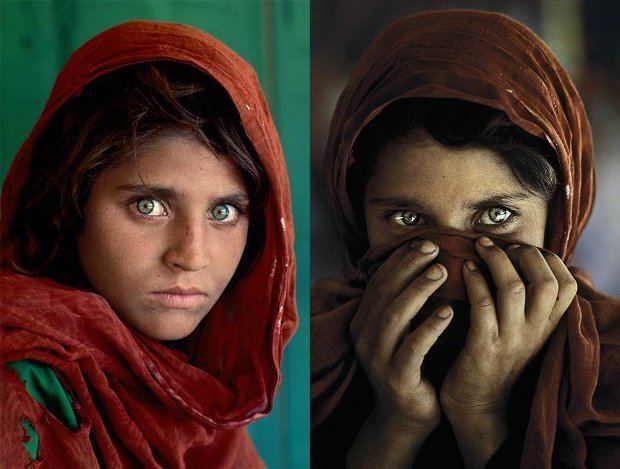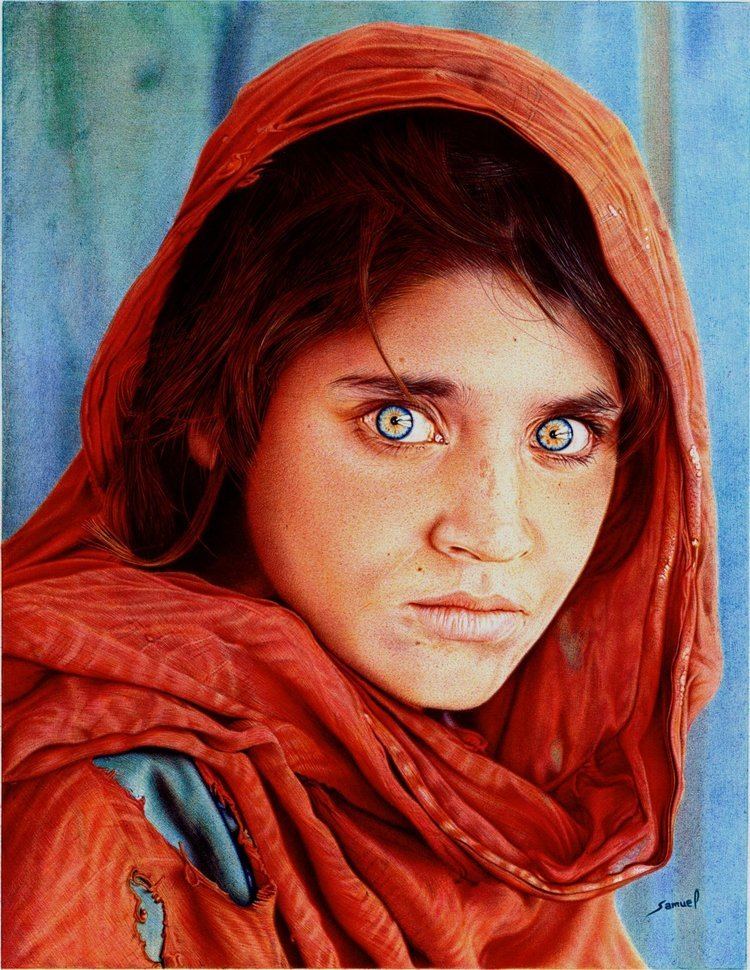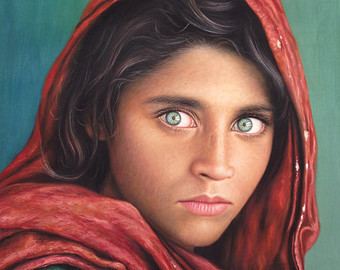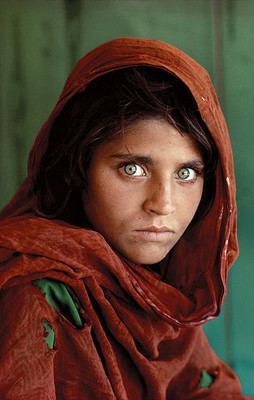Name Afghan Girl Full name Sharbat Gula | Spouse Rahmat Gul | |
 | ||
Children Robina Gul, Alia Gul, Zahida Gul Similar People | ||
The Alternate Take :: Steve McCurry's Afghan Girl Revisited
Afghan Girl- Time-lapse portrait painting
Afghan Girl is a 1984 photographic portrait by journalist Steve McCurry which appeared on the June 1985 cover of National Geographic. The image is of an adolescent girl with green eyes in a red headscarf looking intensely at the camera. It has been likened to Leonardo da Vinci's painting of the Mona Lisa and has been called "the First World's Third World Mona Lisa". The image became "emblematic" of "refugee girl/woman located in some distant camp" deserving of the compassion of the Western viewer.
Contents
- The Alternate Take Steve McCurrys Afghan Girl Revisited
- Afghan Girl Time lapse portrait painting
- National Geographic
- Sharbat Gula
- Legacy
- In popular culture
- References

In early 2002 the subject of the photo was identified as Sharbat Gula (Pashto: شربت ګله) (pronounced [ˈʃaɾbat]) (born ca. 1972), also known as Sharbat Bibi, an Afghan woman who was living in the Nasir Bagh refugee camp in Pakistan during the time of the Soviet occupation of Afghanistan when she was photographed.

National Geographic

Gula was one of the students in an informal school in the Nasir Bagh refugee camp in 1984. Gula's photograph was taken by National Geographic Society photographer Steve McCurry on Kodachrome 64 color slide film, with a Nikon FM2 camera and Nikon 105mm Ai-S F2.5 lens. The pre-print photo retouching was done by Graphic Art Service, based in Marietta, Georgia. McCurry did not record the name of the person he had photographed.

The picture, titled Afghan Girl, appeared on the June 1985 cover of National Geographic. The image of her face, with a red scarf draped loosely over her head and her eyes staring directly into the camera was named "the most recognized photograph" in the history of the magazine, and the cover itself is one of the most famous of the National Geographic. American Photo magazine says the image has an "unusual combination of grittiness and glamour". Her green eyes are the subject of frequent commentary.

McCurry made several unsuccessful attempts during the 1990s to locate her. In January 2002, a National Geographic team traveled to Afghanistan to locate the subject. McCurry, upon learning that the Nasir Bagh refugee camp was soon to close, inquired of its remaining residents, one of whom knew Gula's brother and was able to send word to her hometown. However, a number of women came forward and identified themselves erroneously as the famous Afghan Girl. In addition, after being shown the 1984 photo, a handful of young men erroneously identified Gula as their wife.

The team located Gula, then around the age of 30, in a remote region of Afghanistan; she had returned to her native country from the refugee camp in 1992. Her identity was confirmed by John Daugman using iris recognition. She recalled being photographed. She had been photographed on only three occasions: in 1984 and during the search for her when a National Geographic producer took the identifying pictures that led to the reunion with Steve McCurry. She had never seen the Afghan Girl image before it was shown to her in January 2002.
Sharbat Gula
Pashtun by ethnicity, Gula's parents were killed during the Soviet Union's bombing of Afghanistan when she was around six years old. Along with her grandmother, brother, and three sisters, she walked across the mountains to Pakistan and ended up in the Nasir Bagh refugee camp in Pakistan in 1984.
She married Rahmat Gul between the age of 13 and 16, and returned to her village in Afghanistan in the mid 1990s. She is now a widow. Gula has three daughters. A fourth daughter died in infancy. She expressed hopes that her children will be able to get an education. A devout Muslim, Gula normally would wear a burka and was hesitant to meet with McCurry, as he was a male from outside the family. When asked if she had ever felt safe, she responded "No. But life under the Taliban was better. At least there was peace and order." Until the National Geographic team found her again, she had never seen the photo of herself as a child. When asked how she had survived, she responded that it was "the will of God".
In 2015, local newspapers in Pakistan reported that the National Database and Registration Authority (NADRA) canceled the Computerized National Identity Card (CNIC) to Sharbat Bibi and two men listed as her sons. Reports claimed the national ID cards had been issued illegally. A NADRA source is quoted as saying "They may not be her sons but this is a common practice among Afghan refugees whereby they list names of non-relatives as their children to obtain documents." A relative stated that the family lives in Pakistan, but "We travel between Pakistan and Afghanistan depending on the security situation."
On 26 October 2016, Gula was arrested in Pakistan by the Federal Investigation Agency for living in the country using forged documents. She was sentenced to fifteen days in detention, and she was deported to Afghanistan. The decision was criticised by Amnesty International.
Legacy
Interest in the photo increased after 9/11 attacks when the George W. Bush administration began using women's rights to help promote support for the war in Afghanistan.
More recent pictures of Gula were featured as part of a cover story on her life in the April 2002 issue of National Geographic and she was the subject of a television documentary, entitled Search for the Afghan Girl, which aired in March 2002. In recognition of her, National Geographic set up the Afghan Girls Fund, a charitable organization with the goal of educating Afghan girls and young women. In 2008, the scope of the fund was broadened to include boys and the name was changed to Afghan Children's Fund. After finding Gula, National Geographic also covered the costs of medical treatment for her family, and paid for the costs of a pilgrimage to Mecca.
In popular culture
Finnish symphonic metal band Nightwish released an instrumental song "The Eyes of Sharbat Gula" in their 2015 album Endless Forms Most Beautiful. The song was inspired by McCurry's Afghan Girl photo.
